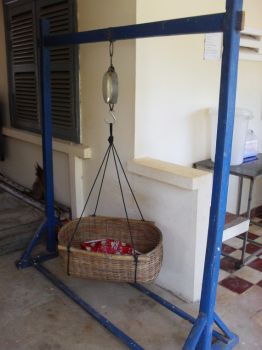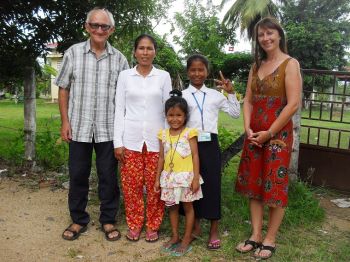Meeting Srey Da in Cambodia
Our child sponor, Eric is a Professor of Social Work and has written a technical blog about his visit to Cambodia - with some fantastic photos! We recently had the opportunity to visit our sponsored child, Srey Da in rural Cambodia, not too far from Phnom Penh, the capital.
We recently had the opportunity to visit our sponsored child, Srey Da in rural Cambodia, not too far from Phnom Penh, the capital.
Background
Cambodia is one of the world’s poorest countries. Around half of the Cambodian government budget comes from external donor assistance, including the Asian Development Bank, the World Bank and the International Monetary Fund. Almost one third of its 14 million population lives on less than US$1.25 per day and life expectancy is around 63 years. More than one third of children under the age of 5 years suffer from chronic malnutrition and stunted growth. The mortality rate for under 5s is 51/1000. The country is a key transit and destination point in the global commercial sex trade, affecting thousands of women and children from Cambodia itself, as well as other parts of Asia. Limited educational opportunities, high income inequality, and poor job prospects pose key challenges to long-term socio-economic development.
World Vision in Cambodia
World Vision has been working in Cambodia since the early 1970s. In 1975 it was forced to abandon its work during the Khmer Rouge regime, resuming operations in 1979.
Our day with World Vision began with a pick-up from our hotel in Phnom Penh by the local Sponsorship Co-ordinator for the two-hour-drive to the community of our sponsored child. En route, our guide provided us with useful information about the work of World Vision in Cambodia.
In the area we visited, World Vision is engaged in working with local communities to develop effective and efficient cultivation techniques and animal husbandry methods in order both to improve income levels and promote the production of nutritious food. They also aim to improve sanitation, access to safe water supplies and to promote improved hygiene. In terms of education, they provide safe learning environments for children in schools. Finally, they ensure access to good quality healthcare, especially for mothers and children. World Vision has delayed its planned exit from the area because, despite its efforts to date, levels of childhood stunted growth remain too high.
A day to remember
 Our first port of call was the Health Centre that incorporates an Integrated Maternal Newborn Survival Project funded by the Mitsubishi Corporation. Here we had the opportunity to talk to staff and a young woman who was resting in the unit having just given birth.
Our first port of call was the Health Centre that incorporates an Integrated Maternal Newborn Survival Project funded by the Mitsubishi Corporation. Here we had the opportunity to talk to staff and a young woman who was resting in the unit having just given birth.
From here we travelled to the Area Development Programme (ADP) office to meet with local World Vision staff. The highlight of our visit was our long-anticipated meeting with our sponsor child, Srey Da, her mother and younger sister. Over lunch we were able to learn about our young friend’s daily life and her hopes and plans for the future. It was inevitable that we would contrast the comparatively luxurious life-style we and our own families enjoy with the privations of family life in rural Cambodia. This was accentuated when after lunch and bidding farewell to our sponsored child and  her mother and sister, we set off for our next destination in the comfort of World Vision’s SUV while the family set off on bicycles to ride the 8 km back to their home in the Cambodian countryside.
her mother and sister, we set off for our next destination in the comfort of World Vision’s SUV while the family set off on bicycles to ride the 8 km back to their home in the Cambodian countryside.
Our next and final visit was to a self-help club run by local teenagers for children. This acts as an out-of-school educational facility to help teach young children general knowledge, basic hygiene and to improve English language skills. Once embarrassment and the barriers of self –consciousness had been overcome the young people began to engage us in conversation, enabling them to learn more about us and us to learn more about them.
It was impressive to see the teenagers taking on leadership and mentorship roles with their younger peers and to feel comfortable in discussing the barriers they had experiencing. For example, some elders in the community questioned their ability and skills in running the out-of-school club and there was a lack of boys in the club. Nevertheless, they had constructed a suitable weatherproof building in which to hold classes which is especially important during the rainy season, and were in the process of trying to recruit more male participants to the club.
Overall, this was a very enjoyable visit, providing us with an opportunity to see first-hand the valuable work being achieved through the Child Sponsorship programme.

We always love reading the stories of our sponsors who visit their sponsored children in the field. It's great that Eric has got so many lovely photos to remind him of his time in Cambodia. Tell us on Facebook about what you would treasure most from visiting your sponsored child.